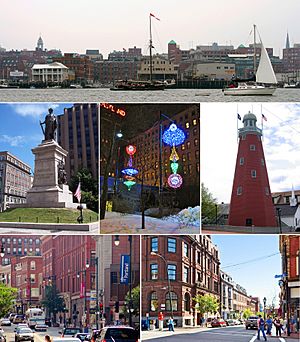Portland metropolitan area, Maine facts for kids
Quick facts for kids
Portland Metropolitan Area
|
|
|---|---|

Clockwise: Portland waterfront, the Portland Observatory on Munjoy Hill, the corner of Middle and Exchange Street in the Old Port, Congress Street, the Civil War Memorial in Monument Square, and winter light sculptures in Congress Square Plaza
|
|
| Country | |
| States | |
| Principal cities | Portland Lewiston South Portland Auburn |
| Other cities | Biddeford Brunswick Sanford Scarborough |
| Time zone | UTC−5 (EST) |
| • Summer (DST) | UTC−4 (EDT) |
The city of Portland, Maine, is the main city in a large area of southern Maine. This area is often called Greater Portland or the Portland metropolitan area. It's a busy and important part of the state.
The U.S. government uses different ways to describe this area for statistics. One way is the Portland–South Portland, Maine, Metropolitan Statistical Area (MSA). This MSA includes three counties in Maine: Cumberland, Sagadahoc, and York. The cities of Portland and South Portland are the biggest cities in this MSA. In 2020, about 551,740 people lived here.
There's also a bigger area called the Portland–Lewiston–South Portland Combined Statistical Area (CSA). This CSA combines the Portland–South Portland MSA with another nearby MSA, the Lewiston–Auburn MSA. The CSA includes four counties in southern Maine.
The Greater Portland area is becoming a major center for creative jobs and businesses. This growth also means some neighborhoods are changing, a process called gentrification.
Contents
Understanding the Metropolitan Area
The Portland–South Portland Metropolitan Statistical Area (MSA) is a way the government groups together cities and towns that are closely connected. It helps them understand how people live and work in a region.
Cities in the MSA
The main cities in the Portland–South Portland MSA are Portland and South Portland. Other important cities in this area include:
Population Changes Over Time
| Historical population | |||
|---|---|---|---|
| Census | Pop. | %± | |
| 1900 | 100,689 | — | |
| 1910 | 112,014 | 11.2% | |
| 1920 | 124,376 | 11.0% | |
| 1930 | 134,645 | 8.3% | |
| 1940 | 146,000 | 8.4% | |
| 1950 | 169,201 | 15.9% | |
| 1960 | 304,946 | 80.2% | |
| 1970 | 327,556 | 7.4% | |
| 1980 | 384,250 | 17.3% | |
| 1990 | 441,257 | 14.8% | |
| 2000 | 487,568 | 10.5% | |
| 2010 | 514,098 | 5.4% | |
| 2020 | 551,740 | 7.3% | |
| U.S. Decennial Census | |||
The population of the Portland–South Portland MSA has grown a lot over the years. In 1900, about 100,000 people lived here. By 2020, that number had grown to over 550,000 people. This shows how much the area has developed.
In 2000, the average income for a household in the MSA was about $43,195. For families, the average income was around $51,873.
Exploring the Combined Statistical Area
The Portland–Lewiston–South Portland Combined Statistical Area (CSA) is an even larger area. It connects the Portland–South Portland MSA with the Lewiston–Auburn MSA. This means it includes four counties in Maine.
Parts of the CSA
The CSA is made up of these two metropolitan areas:
- Portland-South Portland MSA (including Cumberland, Sagadahoc, and York counties)
- Lewiston-Auburn MSA (including Androscoggin County)
In 2000, about 591,361 people lived in this larger CSA. By 2009, the population was estimated to be even higher, around 623,365 people.
New England City and Town Areas (NECTAs)
Another way the government defines metropolitan areas in New England is through something called a New England City and Town Area (NECTA). NECTAs are usually more detailed because they focus on specific cities and towns, not just whole counties.
The Portland–South Portland, ME Metropolitan NECTA includes 24 cities and towns in Cumberland County, 14 in York County, and the town of Durham in Androscoggin County.
Other parts of southern Maine are also grouped into different NECTAs. For example, the towns of Sanford and Shapleigh in York County form the Sanford, Maine, Micropolitan NECTA. The Brunswick, Maine, Micropolitan NECTA includes towns in Cumberland, Sagadahoc, and Lincoln County.
Some towns in York County are even part of NECTAs centered in New Hampshire, like the Dover-Durham, NH-ME Metropolitan NECTA and the Portsmouth, NH-ME Metropolitan NECTA.
Just like the CSA, there's also a Portland–Lewiston–South Portland Combined NECTA. This combines the Portland–South Portland and Lewiston–Auburn Metropolitan NECTAs with the Brunswick and Sanford Micropolitan NECTAs.
Maine uses NECTAs to help define labor market areas. These areas are important for tracking jobs and unemployment statistics. For example, the Portland–South Portland Metropolitan Area and the Sanford Micropolitan Area are combined to form the Portland–South Portland–Sanford combined statistical area for labor market purposes.
See also
 In Spanish: Área metropolitana de Portland-South Portland-Biddeford para niños
In Spanish: Área metropolitana de Portland-South Portland-Biddeford para niños

